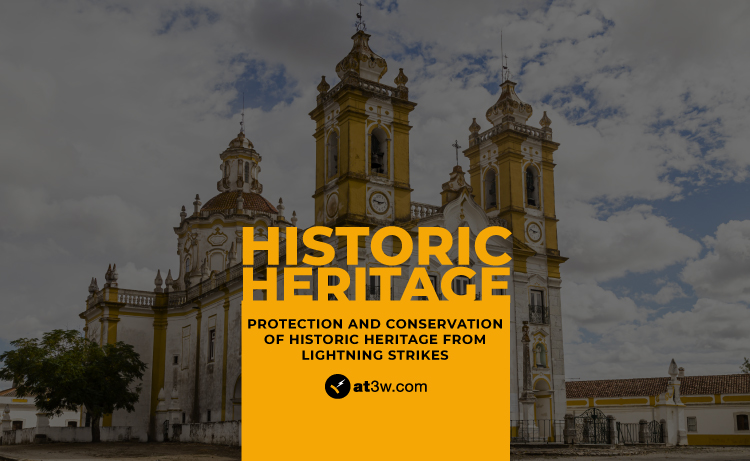Lightning protection for buildings is crucial to avoid personal, material and economic damage. If they are also historic buildings, lightning can cause incalculable artistic and heritage losses. For this reason, Aplicaciones Tecnológicas designs and offers a wide range of products with the aim of minimising the damage that thunderstorms can cause.
It should also be considered that the need for lightning protection increases in historic buildings, as these places are often visited by a large number of tourists due to their high cultural value. In addition, many historic buildings have electronic equipment, such as security cameras, audio-visual and other expensive equipment, which can be damaged by a lightning strike.
Assessing the need for lightning protection
The risk inherent in monuments or heritage buildings is very high, as lightning strikes can cause irreplaceable losses to cultural heritage, for example in museums or archaeological sites. In addition, the installation of lightning conductors or other lightning protection elements in these buildings should be designed to minimise the visual impact as much as possible and to take care of electrical installations and earthing.
In order to assess the risk, the characteristics of these buildings or monuments must be analysed:
- Type of construction: The material of the structure and the roof influence the risk associated with the building, as the losses will not be the same if it is a metal or reinforced concrete structure, if it is made of brick, stone or even flammable materials, such as wood or thatch.
- Use of the building: The risk of damage to people increases in the case of public buildings, historic buildings, convention centres, places of cult… The admissible risk is also lower if the structure to be protected is difficult to evacuate, or if there is a risk of panic, such as in museums or theatres.
- Location of the building in relation to its surroundings and its height: The risk of lightning strike is higher when it is a structure surrounded by lower buildings, and even higher if it is isolated or on a hill.
- Equivalent capture area of the structure to be protected: The risk depends on the size of the building, especially its height.
- Ground impact density, i.e. the number of lightning strikes per square kilometre per year of the site on which the building is located.
The regulations provide risk calculations, taking these and other factors into consideration, and indicate the measures to be taken. In any case, the risk associated with the loss of cultural heritage is always considered particularly high, so it is important to install a high-tech external lightning protection system to protect the structure of historic buildings.
ESE Lightning Arrester, DAT CONTROLER® REMOTE
To minimize the effects of lightning strikes in this type of building, Aplicaciones Tecnológicas has a complete lightning protection system incorporating an innovative lightning arrester with an Early Streamer Emission (ESE) device named DAT CONTROLER® REMOTE. Unlike other lightning protection systems, the Aplicaciones Tecnológicas´ DAT CONTROLER® REMOTE is characterised by emitting a continuous upward tracer before any other object within its protection radius. The further it anticipates the formation of the upward tracer, the greater the distance at which it captures the downward tracer, protecting a larger area. This protection of larger areas makes lightning arresters with an ESE device a safer and more effective lightning protection system for many construction projects where, in addition, a minimum visual impact is required, as in the case of historic buildings.
Likewise, the DAT CONTROLER® REMOTE lightning rod allows to receive, through its auto-diagnosis and communication system, confirmations of the correct and continued operation of the device, without the need of physical access to the installed equipment. This simplifies the periodic maintenance of the lightning protection installation.
Some monuments of great historical value recently protected with DAT CONTROLER® REMOTE
Malacky Castle, Slovakia
DAT CONTROLER® REMOTE lightning rods protect Malacky Castle in Slovakia as well as part of Zamocky Park, the classicist-style park surrounding this 17th century fortress.
Because of its isolated location, with no higher elements around it, and because of the value of this cultural heritage, the Malacky Castle requires lightning protection to ensure the integrity of the building and the safety of visitors.
The DAT CONTROLER® REMOTE lightning conductor offers this protection against lightning strikes in addition to an M2M communication system. This system allows centralised verification of the ESE status via a proprietary web portal, without the need to physically access the lightning conductor.
Nossa Senhora de Aires Sanctuary
The lightning protection system from Aplicaciones Tecnológicas protects the Nossa Senhora de Aires pilgrimage sanctuary, located in Viana do Alentejo, Portugal. This emblematic 18th century building was designed by the architect P. João Baptista.
The external lightning protection of this historic building in the Portuguese baroque style was essential, and for this reason, the lightning arrester with the most advanced technology from Aplicaciones Tecnológicas, the DAT CONTROLER® REMOTE, was installed.
This choice was justified due to the high technology of the equipment, together with its remote verification system. This solution has proved to be key, as we are talking about a building dating from 1743 in which the entire upper part is topped by a balcony with pinnacles at the corners, which makes access to the roof difficult.
Lightning protection study service
Each historical building is singular and has its own unique characteristics, which is why Aplicaciones Tecnológicas studies each particular case, offering the appropriate solutions and providing adequate protection in accordance with the established reference standards.
Our technical support department will study the best solutions for the design, installation and maintenance of lightning protection systems according to their needs.
For any questions about lightning protection elements in historic buildings and cultural heritage you can contact us at the following link.
